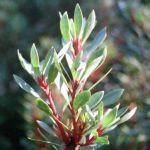| Common Name: |
Mountain Pepper |
| Other Names: |
Native Pepper |
| Botanical Name: |
Tasmannia lanceolata syn. T aromatica, Drimys aromatica |
| Genus: |
Tasmannia |
| Family: |
Winteraceae |
| Native Location: |
Australia (Tasmania, Victoria, New South Wales) |
| Cultivation: |
Moist, well-drained soil in sun or partial shade. |
| Propagation: |
By seed sown when ripe; by semi-ripe cuttings in summer. |
| Harvest: |
Leaves are picked at any time and used fresh, dried-whole, or dried and ground. Berries are collected when ripe and dried, frozen, pickled in brine, or packed in salt. Flower buds are collected in spring and used fresh. Bark is stripped from prunings and dried. |
| Height: |
4m (12ft) |
| Width: |
2.5m (8ft) |
| Hardiness: |
Z8 |
| Parts Used: |
Leaves, fruits, flower buds, bark. |
| Properties: |
An aromatic, stimulant herb with a pungent, peppery flavor. |
| Medicinal Uses: |
Bark has similar properties to Winter's Bark (Drimys winteri). |
| Culinary Uses: |
Flower buds can be used to flavor salads. Ground, dried leaves and berries are used in the same way as pepper. Bark is made into tea. |
| Bibliography: |
Encyclopedia of Herbs by Deni Brown Copyright © 1995, 2001 Dorling Kindersley Limited Pg 383 |

